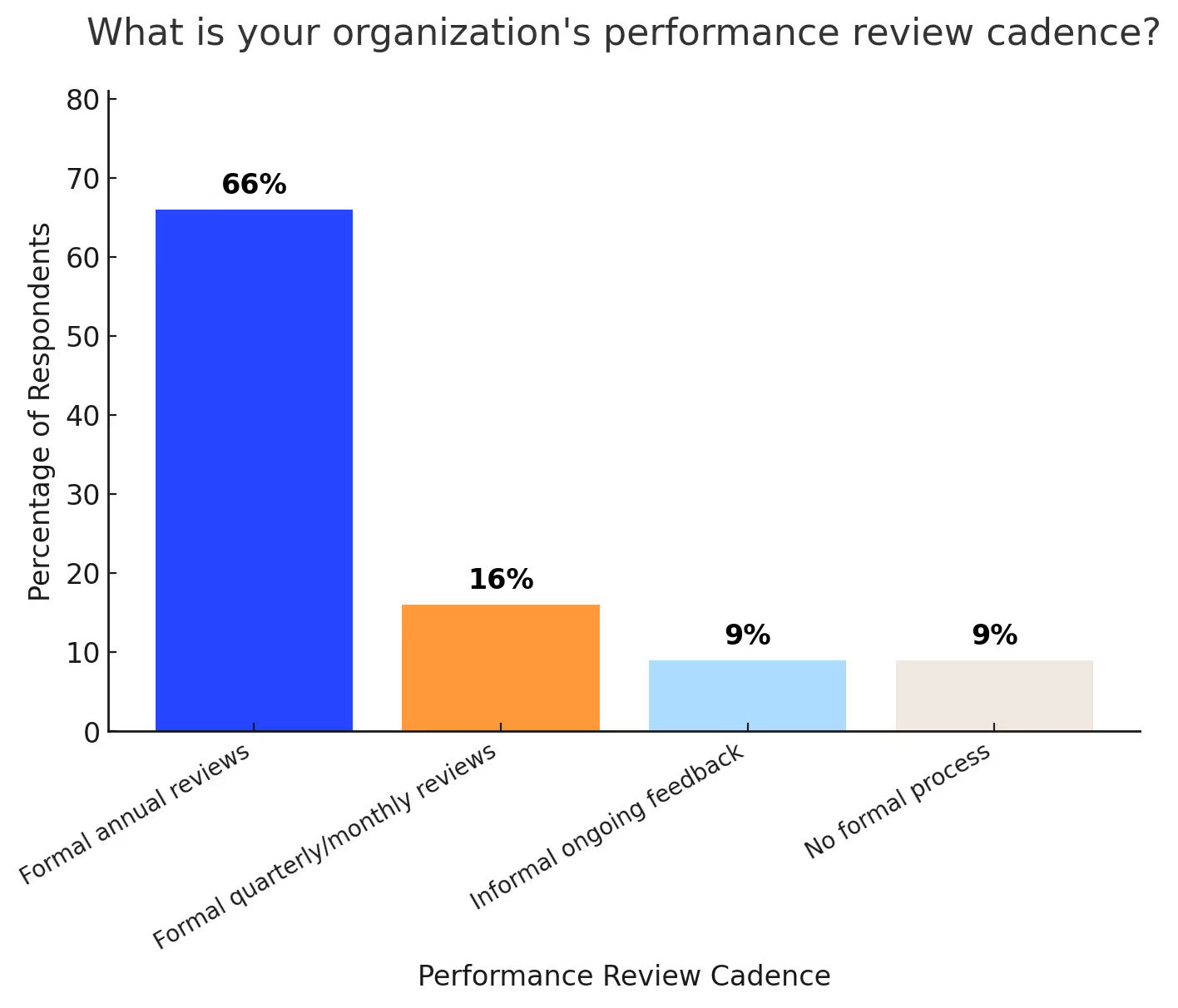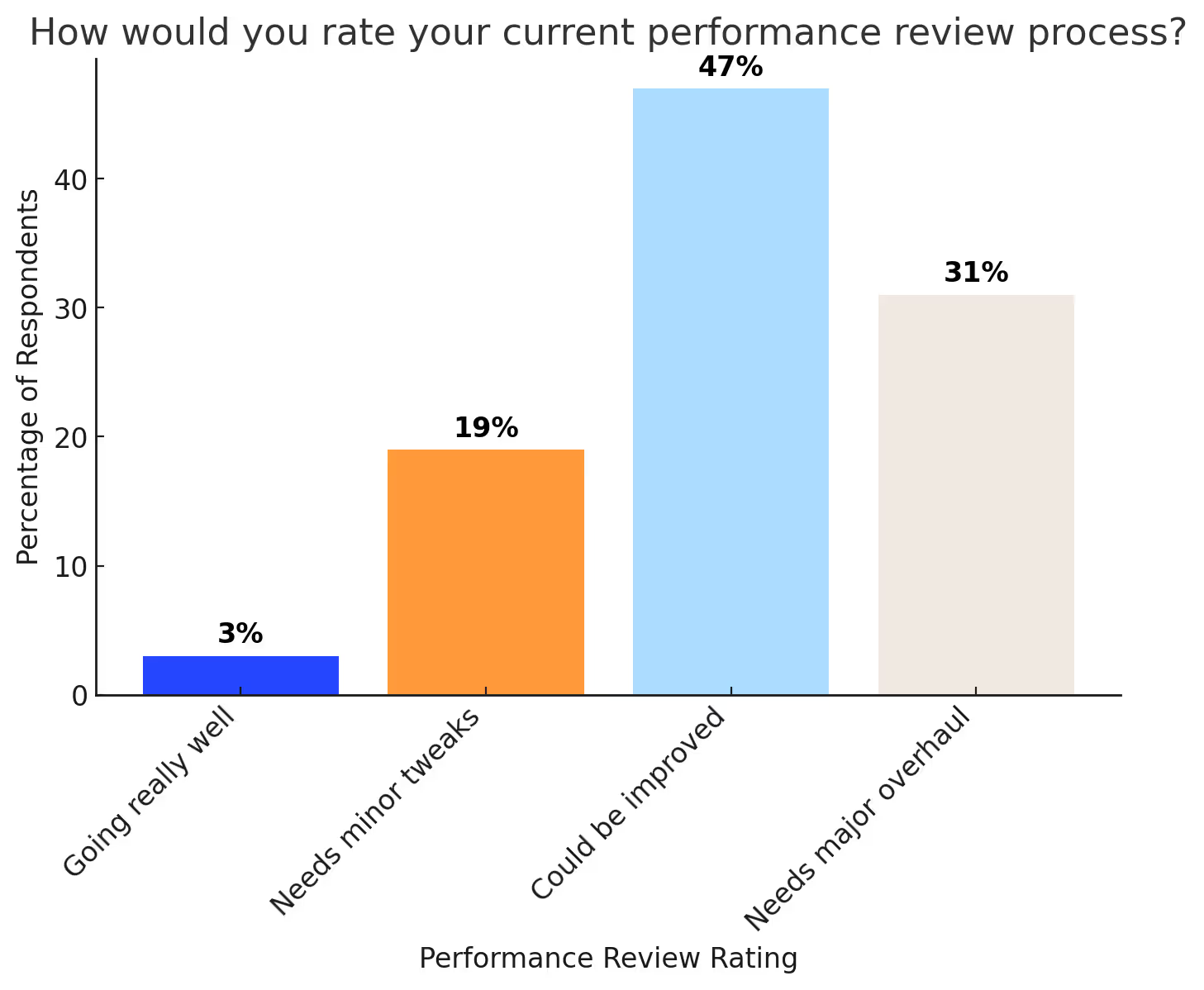Why annual reviews fail and what HR can do to prevent it: Insights from our latest webinar
.avif)
%20(1).png)
Annual performance reviews have long been a cornerstone of workplace culture, but are they serving employees and organizations effectively? In a recent Workleap webinar, our expert panel tackled this question head-on, exploring why traditional performance reviews often fall short and what HR leaders can do to create a more effective, continuous performance management system.
Featuring insights from Ricky Muddimer, Co-founder at Thinking Focus; Irina Mocanu, Senior HR Advisor at Workleap; and Brian O'Reilly, Performance Management Product Director at Workleap, the discussion left attendees with actionable takeaways for driving meaningful change in their organizations.
Here’s a recap of the key insights and strategies shared during the session.
Annual reviews may be the standard but they’re failing organizations (here’s why!)
Annual reviews have been the default approach for decades, but as workplace needs evolve, many organizations are questioning their effectiveness. During the webinar, we ran two polls to better understand how organizations approach performance management. The results were revealing:
What is your organization's performance review cadence?
- 66% rely on formal annual reviews.
- 16% use formal quarterly or monthly reviews.
- 9% provide informal, ongoing real-time feedback.
- 9% have no formal process at all.

How would you rate your current performance review process?
- Only 3% said it’s "going really well."
- 19% feel it’s working but could use minor tweaks.
- 47% admitted it could be improved.
- 31% said it needs a major overhaul.

These results highlight the problem: while annual reviews remain the standard, they often fail to deliver on their promise of fostering engagement and driving performance. “The annual review isn’t the issue in itself,” said Irina Mocanu. “The issue arises when it’s the only touchpoint for feedback all year long.”
This gap leaves employees feeling blindsided and disengaged. When feedback is only delivered once a year, it’s impossible to address problems early or celebrate successes when they happen.
4 ways to improve your performance management approach
If annual reviews are just one piece of the puzzle, what does an effective performance management system look like? During the discussion, the panel outlined four foundational principles:
1. Create a regular rhythm of feedback
Regular check-ins between managers and employees are critical for keeping communication lines open. These touchpoints prevent surprises during formal reviews and allow managers to address issues early. Ricky Muddimer emphasized that the frequency of these check-ins should depend on the organization.
“Rhythm means addressing issues early — when someone needs a little support, for example — and celebrating successes consistently. Whether it’s daily, weekly, or bi-weekly, find a cadence that works for your team,” he says. “It’s important to do a sense check of how your people are doing so there are no surprises come the annual review”
2. Establish a compelling "why”
Performance management should feel valuable for everyone involved. As Ricky explained, “When managers and employees view performance management as an opportunity for growth and connection, it becomes something they actively want to participate in.” Employees want to know their managers are invested in their development, and managers need to see these conversations as opportunities to build stronger teams.
3. Keep it simple
Performance management often gets bogged down by administrative tasks and bureaucracy. But the focus should always be on people. Ricky put it best: “Your performance management approach has to be simple and easy to use. It must prioritize people over the process.” Simplicity ensures managers and employees can spend their energy on meaningful conversations, not paperwork.
4. Monitor your approach
A great performance management system isn’t a one-and-done implementation — it requires continuous refinement. As Irina emphasized, “Monitor what works, what doesn’t work, and adapt. If you stop, in three years, you’ll realize your performance management system is out of date.”
To keep processes relevant and effective, HR teams should regularly assess their approach, gather feedback from managers and employees, and make small, incremental improvements rather than waiting for major overhauls.
Overcoming barriers to continuous feedback
Transitioning from annual reviews to a more continuous feedback model isn’t easy, but the benefits are undeniable. The panel shared their thoughts on the most common challenges organizations face — and how to overcome them.
Cultural shifts take time
Implementing a new performance management system often requires a cultural transformation. The panelists encouraged HR leaders to be patient with this process: “Start small and implement changes incrementally rather than overhauling the entire system at once. Progress, not perfection, should be the goal.” By starting with small wins, organizations can gradually build a foundation for larger changes.
Managers need support
One of the biggest barriers to continuous feedback is managers’ reluctance to have difficult conversations — and the HR leaders agreed wholeheartedly in the webinar chat.
“Often managers aren’t comfortable/haven’t had enough training [on how to have] difficult conversations and giving and receiving feedback,” one attendee shared. “The problem is everything in training sounds great until it has to come out of your own mouth,” said another HR leader.
To help managers build confidence in performance conversations, organizations need to reinforce training with ongoing support and accountability. As Irina and Ricky pointed out, training alone isn’t enough — HR leaders need to check in with managers regularly to understand their challenges and ensure feedback is meaningful and actionable.
One approach is setting clear expectations, like Amazon’s leadership principles, which define how managers should foster high-performing teams. Another is directly evaluating managers on how well they implement continuous feedback and whether their team is high-performing. Ultimately, driving this cultural shift requires not only equipping managers but also empowering employees to take ownership of their performance and feedback.
Prioritizing continuous feedback requires ongoing effort
Many managers, especially leader do-ers juggling multiple roles, struggle to make time for regular check-ins. Day-to-day operations often take priority, making structured performance conversations an afterthought. However, avoiding these discussions can lead to bigger issues down the line.
Managers already spend time addressing problems caused by a lack of clarity. Instead of reacting to issues, a proactive approach — setting clear expectations and providing regular feedback — prevents problems from escalating. Organizations that prioritize frequent check-ins see fewer performance gaps and build stronger, more engaged teams.
How technology can help
Technology has become an essential tool for streamlining performance management and reducing administrative burdens. Brian O’Reilly shared how Workleap’s tools are designed to make performance management easier and more impactful.
“Having a central spot to document one-on-ones and goals ensures no progress gets lost or forgotten,” Brian explained. Tools that centralize feedback and provide insights — both quantitative and qualitative — make it easier for managers to focus on meaningful conversations.
AI also plays a role in enhancing performance management. “One of the major issues of the annual review model is recency bias,” Brian said. “AI, in conjunction with using the right tools and having access to the right performance insights, can help give managers extra context and cognitive load.” This allows managers to consider an employee’s entire body of work rather than focusing on recent events.
Voices from the webinar chat
Throughout the webinar, attendees actively engaged in the discussion, sharing their own challenges and perspectives on performance management. Their insights reinforced the importance of consistency, effective feedback, and balancing accountability with empathy. Here are a few standout comments that resonated:
- On leaders being consistent: “My mantra has always been: be fair and consistent in all you do and who you interact with. That goes a long way.”
- On feedback as an opportunity: “We need to teach people how to have difficult conversations, not just conversations. Start with the positive and position feedback as an opportunity for growth.”
- On balancing humanity with performance: “There are ways to ensure that people understand they are valued and that it’s human not to be perfect. That notwithstanding, we need to be honest — in strict behavioral terms — about areas of improvement.”
These comments reflect the shared challenges and aspirations of HR leaders striving to make performance management more human and effective. Kick off your performance revamp with these key takeaways Bringing all these insights together, our panelists shared essential takeaways for HR leaders looking to transition from outdated performance reviews to a more continuous, human-centered approach:
- Redefine performance: Start by defining what performance means in your organization. At Workleap, we focus on two dimensions: behaviors (e.g., embracing change, innovation) and accomplishments (e.g., the impact of work). “Defining performance criteria that align with your culture is essential,” Irina said.
- Integrate feedback into existing rituals: Reinforcing continuous feedback doesn’t mean reinventing the wheel. "When you embed continuous feedback sharing into existing ways of working, it becomes a much more natural process and it’s much easier for leaders to build this reflex,” says Irina.
- Engage employees and managers: Equip managers with the tools, training, and support they need to have meaningful conversations and empower employees to take ownership of their own growth. It’s important to constantly remind them of your “why,” so they can feel accountable.
- Refine and adapt: Gather feedback after implementation to refine the process. As Ricky noted, “This is about progress, not perfection. Set incremental goals and adjust as needed.”
Want to dive deeper? Catch the full conversation and get expert insights on how to transform performance management
The insights shared during this webinar are just the beginning. To hear more about how to navigate cultural shifts, leverage technology, and foster a culture of continuous feedback, watch the full recording. Transforming performance management isn’t easy, but the rewards — increased engagement, better alignment, and stronger teams — are well worth the effort.
Give HR and managers the clarity, confidence, and connection to lead better every day.


%20(1).avif)


.avif)
.avif)

.avif)





